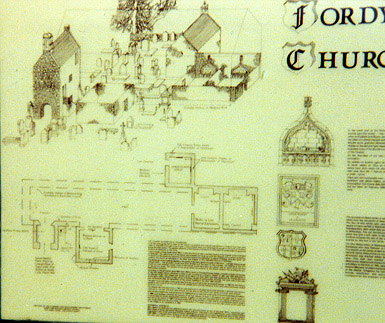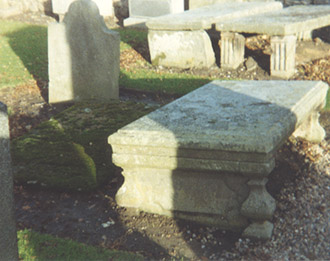

Fordyce Parish, Banffshire, Scotland
Fordyce Parish in the 1800's (nineteenth century)
Written and researched by Margaret Odrowaz-Sypniewska, B.F.A.

Fordyce Parish, containing the post-towns of Portsoy and Fordyce, and the villages of Sandend and Newmills, on the coast of Banffshire. It is bounded by the Moray frith, and by the parishes of Boyndie, Ordiquhill, Grange, Deskford, and Cullen. Its outline is nearly triangle, with a base or shortest side on the coast, and the apex on the south; and it measures about 6 miles along the coast about 8 miles inland, and about 28 square miles in area. The coast is somewhat bold and rocky, and has some conspicuous headlands, but is indented by two bays, that of Portsoy, where there is a good commodious harbour; and that of Sandend, where there is a sandy beach of about a half-a-mile in length. Several caves penetrate the coast rocks, though not to any great depth; and an interesting object adjacent to one of these is the old castle of Findlater.

The general surface of the parish is diversified; part of it being a fine flat, with frequent inequalities or rising grounds, and part a series of hills, with intervening and flanking vales and dales. In the center of the hills are Down and Fordyce, extending continuously with crescent curves, from north-east to south-west, with an extreme elevation of about 700 feet above sea level. In the south, on the boundary with Grange, rises Knock-hill, with majestic appearance, to an altitude of about 1,300 feet above sea-level, serving as a landmark to mariners throughout a considerable sweep of the Moray frith. Three small rivulets effect most of the drainage, -- the burn of Down to the sea at Portsoy, and the burn of Fordyce to the sea at Sandend bay. The soil varies with the substrata; but in general is deep and fertile, yet naturally wet, so as to require much artificial draining. The New Statistical Account distributes the area into 9,306 imperial acres regularly or occasionally in tillage, 5,960 constantly waste or in pasture, 670 of the latter capable of profitable reclamation, 1,500 in a state of undivided common, and 1,234 under wood. The geognostic features of the parish, particularly in the vicinity of Portsoy, are eminently interesting. A beautiful serpentine occurs in two masses, respectively 73 feet and 1,500 feet wide. "Along with it hornblende-slate, quartz rock, clayslate, limestone, and talc or mica-slate, with granite veins occur in various alterations; but their exact relations to this rock are not very clearly exhibited. The colours of the rock are different shades of green and red, disposed in clouds, veins, spots, and dots; all these varieties being sometimes found even in hand specimens. Yellowish, and greyish-white tints also occur. Its structure is massive, with an uneven splintery fracture. It contains numerous imbedded minerals, as asbetos, amianthus, mountain cork, steatite, talc, schiller spar, magnetic iron, chromate of iron, etc. It is often named Portsoy marble, and is much valued as an ornamental stone, having been even exported to France, to adorn the palace of Versailles." In the same neighborhood occur also veins of graphite granite, comprising quartz and feldspar crystals so arranged, that the polished surface resembles rudely formed letters. A beautiful quartz rock, suitable for potteries, is quarried on the north side of the hill of Durn for exportation to England. Limestone is worked in three quarries. Sea-fisheries are carried on at Portsoy and Sandend, and a salmon fishery at the mouth of the burn [burn=a stream or rivelet] of Boyne. The landowners are the Earl of Seafield, Sir John Abercromby, Bart., and A. Abercromby, Esquire of Glassaugh -- the last of whom is resident in Glassaugh-house, one of the neatest and largest mansions in the country. The yearly value of raw produce was estimated, in 1849, at 41,250 pds.

Assessed property in 1843, 8,712 pds. 3s, 5d. There are, in this parish, remains of some Druidical temples, with barrows or tumuli, and cairns. in which stone coffins, with skeltons and urns, have been found.There is a triple foss, or rampant, on the sides and the top of the hill of Durn. General Abercromby of Glassaugh was a native of Fordyce; so also, according to some accounts, was Archbishop Sharpe. The village of Fordyce stands in the vale of the Fordyce burn, about 3 miles south-west of Portsoy. It is a burgh of barony, under the Earl of Seafield. It received its first charter in 1499, and another in 1592. Fairs for sheep and cattle are held here on the last Wednesday of October, and on the fourth Thursday of November, both old style. Population of the village, 212. Population of the parish in 1831, 3,364; in 1861, 4,145. Houses, 777.

This parish is the seat of a presbytery in the synod of Aberdeen. Patron, the Earl of Seafield. Stipend, 245pds. 17s, 2d.; glebe 5 pds. Unappropriated teinds, 771pds, 16s. 3d. The parish church was built in 1804, and contains 1,100 sittings. There is a chapel of ease in Portsoy, which was built in 1815, and contains nearly 700 sittings. It is in the presentation of the Earl of Seafield. There are two Free churches, respectively at Fordyce and Portsoy. Attendance at the Portsoy Free church, 450; summed raised in 1865, 198 pds. 1s. 1d. There are in Portsoy an Episcopalian chapel and a Roman Catholic chapel, the former built in 1841, the latter in 1829. The salary of the parochial schoolmaster is 40pds., with about 30pds in fees, and other emoluments. There are 11 schools besides the parish school; and the majority of them are aided by either public bodies or private subscribers. There are various beneficiary institutions in Portsoy. The parish of Fordyce, previous to the Reformation, comprehended also the district which now forms the parishes of Ordiquhill, Deskford, and Cullen.
RELATED LINKS:
Source: Wilson, Rev. John Marius (editor). The Imperial Gazetteer of Scotland. London: A Fullarton & Co., 504.
This page was last updated on May 19, 2007
